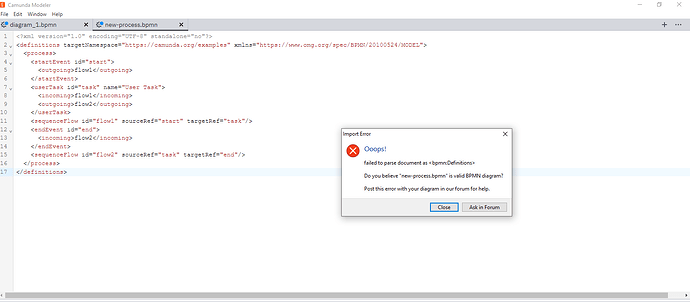Hi Team,
Instead of fluent API, We need to create the shapes dynamically and later we need connect them, Trying to create in Camunda 8 something like below (following a link The new camunda BPMN model API | Camunda),
Kindly could you please help me how to do it in Camunda 8
public void testCreateProcess() {
modelInstance = Bpmn.createEmptyModel();
Definitions definitions = modelInstance.newInstance(Definitions.class);
definitions.setTargetNamespace("https://camunda.org/examples");
modelInstance.setDefinitions(definitions);
Process process = modelInstance.newInstance(Process.class);
definitions.addChildElement(process);
StartEvent startEvent = modelInstance.newInstance(StartEvent.class);
startEvent.setId("start");
process.addChildElement(startEvent);
UserTask userTask = modelInstance.newInstance(UserTask.class);
userTask.setId("task");
userTask.setName("User Task");
process.addChildElement(userTask);
SequenceFlow sequenceFlow = modelInstance.newInstance(SequenceFlow.class);
sequenceFlow.setId("flow1");
process.addChildElement(sequenceFlow);
connect(sequenceFlow, startEvent, userTask);
EndEvent endEvent = modelInstance.newInstance(EndEvent.class);
endEvent.setId("end");
process.addChildElement(endEvent);
sequenceFlow = modelInstance.newInstance(SequenceFlow.class);
sequenceFlow.setId("flow2");
process.addChildElement(sequenceFlow);
connect(sequenceFlow, userTask, endEvent);
Bpmn.writeModelToFile(new File("target/new-process.bpmn"), modelInstance);
}
connect(SequenceFlow flow, FlowNode from, FlowNode to) {
flow.setSource(from);
from.getOutgoing().add(flow);
flow.setTarget(to);
to.getIncoming().add(flow);
}
This code generates the following BPMN 2.0 XML file.
<?xml version="1.0" encoding="UTF-8" standalone="no"?>
<definitions targetNamespace="https://camunda.org/examples" xmlns="https://www.omg.org/spec/BPMN/20100524/MODEL">
<process>
<startEvent id="start">
<outgoing>flow1</outgoing>
</startEvent>
<userTask id="task" name="User Task">
<incoming>flow1</incoming>
<outgoing>flow2</outgoing>
</userTask>
<sequenceFlow id="flow1" sourceRef="start" targetRef="task"/>
<endEvent id="end">
<incoming>flow2</incoming>
</endEvent>
<sequenceFlow id="flow2" sourceRef="task" targetRef="end"/>
</process>
</definitions>
Hi @SAMBASIVARAO_Y,
The fluent API assists you to create BPMN models. The model that you create is not specific to any process engine. To make it executable, you’d need to add engine-specific extension elements. These are documented for each element in our documentation (e.g., Service tasks | Camunda Platform 8 Docs). However, if you want to do lots of configuration, this can be some effort (i.e., the fluent API does not have any methods for this out-of-the-box).
Hi @StephanHaarmann ,
With the FluentAPI, We can create the tasks one after another, But We need to create the list of tasks/nodes and later we need to have set of connections among them something like below.
Could you please let us know how we can do in Camunda 8?
Dashboard → { Accounts, Transactions, Budgets, Reports }
Accounts → { Dashboard, Transactions, Budgets, Reports }
Transactions → { Dashboard, Accounts, Budgets, Reports }
Budgets → { Dashboard, Accounts,Transactions, Reports }
Reports → { Dashboard, Accounts,Transactions,Budgets }
This looks like you want to connect everything to (almost) everything else.
Using the BPMN Model API, you can add arbitrary sequence flows between nodes.
Just repeat these steps:
SequenceFlow sequenceFlow = modelInstance.newInstance(SequenceFlow.class);
sequenceFlow.setId("flow1");
process.addChildElement(sequenceFlow);
connect(sequenceFlow, startEvent, userTask);
What do you mean by “create it in Camunda 8”?
Thanks @StephanHaarmann for quick turnaround, When we do as you suggested it is generating an ‘xml’ like below.
<?xml version="1.0" encoding="UTF-8" standalone="no"?>
<definitions targetNamespace="https://camunda.org/examples" xmlns="https://www.omg.org/spec/BPMN/20100524/MODEL">
<process>
<startEvent id="start">
<outgoing>flow1</outgoing>
</startEvent>
<userTask id="task" name="User Task">
<incoming>flow1</incoming>
<outgoing>flow2</outgoing>
</userTask>
<sequenceFlow id="flow1" sourceRef="start" targetRef="task"/>
<endEvent id="end">
<incoming>flow2</incoming>
</endEvent>
<sequenceFlow id="flow2" sourceRef="task" targetRef="end"/>
</process>
</definitions>
When I’m opening that xml in the modeler, it is giving me an error.
Have you tried to verify the model?
Bpmn.validateModel(modelInstance);
This may give you some more details on what went wrong.
My guess is that the definitions should look more like this:
<bpmn:definitions xmlns:bpmn="http://www.omg.org/spec/BPMN/20100524/MODEL" xmlns:bpmndi="http://www.omg.org/spec/BPMN/20100524/DI" xmlns:dc="http://www.omg.org/spec/DD/20100524/DC" xmlns:xsi="http://www.w3.org/2001/XMLSchema-instance" xmlns:di="http://www.omg.org/spec/DD/20100524/DI" targetNamespace="https://camunda.org/examples">
And the XML elements should subsequently be prefixed.
